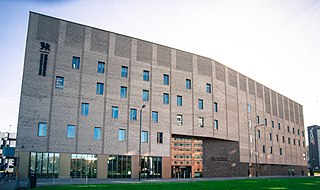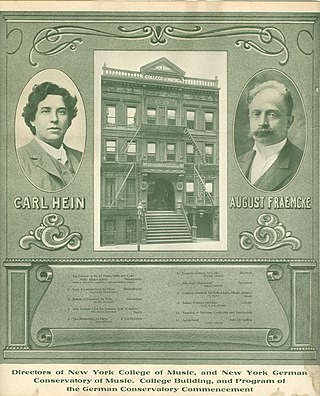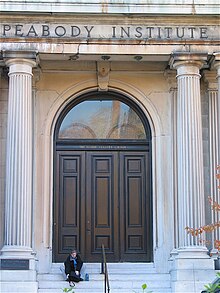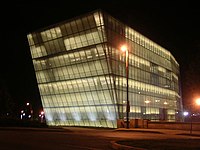
The Royal Conservatory of Music, branded as The Royal Conservatory, is a non-profit music education institution and performance venue headquartered in Toronto, Ontario, Canada. It was founded in 1886 by Edward Fisher as The Toronto Conservatory of Music. In 1947, King George VI incorporated the organization through royal charter. Its Toronto home was designated a National Historic Site of Canada in 1995, in recognition of the institution's influence on music education in Canada. Tim Price is the current Chair of the Board, and Peter Simon is the President.

The N. A. Rimsky-Korsakov Saint Petersburg State Conservatory is a school of music in Saint Petersburg, Russia. In 2004, the conservatory had around 275 faculty members and 1,400 students.

The Moscow Conservatory, also officially Moscow State Tchaikovsky Conservatory is a musical educational institution located in Moscow, Russia. It grants undergraduate and graduate degrees in musical performance and musical research. The conservatory offers various degrees including Bachelor of Music Performance, Master of Music and PhD in research.

The Hochschule für Musik Hanns Eisler Berlin in Berlin, Germany, is one of the leading universities of music in Europe. It was established in East Berlin in 1950 as the Deutsche Hochschule für Musik because the older Hochschule für Musik Berlin was in West Berlin. After the death of one of its first professors, composer Hanns Eisler, the school was renamed in his honor in 1964. After a renovation in 2005, the university is located in both Berlin's famed Gendarmenmarkt and the Neuer Marstall.

Leon Fleisher was an American classical pianist, conductor and pedagogue. He was one of the most renowned pianists and pedagogues in the world. Music correspondent Elijah Ho called him "one of the most refined and transcendent musicians the United States has ever produced".

Enoch Pratt was an American businessman in Baltimore, Maryland. Pratt was also a committed active Unitarian, and a philanthropist. He is best known for his donations to establish the Enoch Pratt Free Library in Baltimore and expanding the former Sheppard Asylum to become The Sheppard and Enoch Pratt Hospital,, located north of the city in western Towson, county seat of Baltimore County. Born and raised in Massachusetts, he moved south to the Chesapeake Bay area and became devoted to the civic interests of the city of Baltimore. He earned his fortune as an owner of business interests beginning in the 1830s originally as a hardware wholesaler, and later expanding into railroads, banking and finance, iron works, and steamship lines and other transportation companies.

Mount Vernon is a neighborhood of Baltimore, Maryland, located immediately north of the city's downtown. It is named for George Washington's Mount Vernon estate in Virginia, as the site of the city's Washington Monument.
The Cleveland Institute of Music (CIM) is a private music conservatory in Cleveland, Ohio. The school was founded in 1920 by a group of supporters led by Martha Bell (Mrs. Franklyn B.) Sanders and Mary Hutchens (Mrs. Joseph T.) Smith, with Ernest Bloch serving as its first director. CIM enrolls 325 students in the conservatory and approximately 1,500 students in the preparatory and continuing education programs. There are typically about 100 openings per year for which 1,000-1,200 prospective students apply.
The music of Baltimore, the largest city in Maryland, can be documented as far back as 1784, and the city has become a regional center for Western classical music and jazz. Early Baltimore was home to popular opera and musical theatre, and an important part of the music of Maryland, while the city also hosted several major music publishing firms until well into the 19th century, when Baltimore also saw the rise of native musical instrument manufacturing, specifically pianos and woodwind instruments. African American music existed in Baltimore during the colonial era, and the city was home to vibrant black musical life by the 1860s. Baltimore's African American heritage to the start of the 20th century included ragtime and gospel music. By the end of that century, Baltimore jazz had become a well-recognized scene among jazz fans, and produced a number of local performers to gain national reputations. The city was a major stop on the African American East Coast touring circuit, and it remains a popular regional draw for live performances. Baltimore has produced a wide range of modern rock, punk and metal bands and several indie labels catering to a variety of audiences.
Adam Itzel Jr. was a 19th-century American conductor, pianist, and composer active in Baltimore.
The USC Thornton School of Music is a private music school in Los Angeles, California. Founded in 1884 only four years after the University of Southern California, the Thornton School is the oldest continually operating arts institution in Los Angeles. The school is located on the USC University Park Campus, south of Downtown Los Angeles.

The Royal Birmingham Conservatoire is a music school, drama school and concert venue in Birmingham, England. It provides education in music, acting, and related disciplines up to postgraduate level. It is a centre for scholarly research and doctorate-level study in areas such as performance practice, composition, musicology and music history. It is the only one of the nine conservatoires in the United Kingdom that is also part of a faculty of a university, in this case Arts, Design and Media at Birmingham City University. It is a member of the Federation of Drama Schools, and a founder member of Conservatoires UK.
The American Conservatory of Music (ACM) was a major American school of music founded in Chicago in 1886 by John James Hattstaedt (1851–1931). The conservatory was incorporated as an Illinois non-profit corporation. It developed the Conservatory Symphony Orchestra and had numerous student recitals. The oldest private degree-granting music school in the Midwestern United States, it was located in Chicago until 1991.

The George Peabody Library is a library connected to the Johns Hopkins University, focused on research into the 19th century. It was formerly the Library of the Peabody Institute of music in the City of Baltimore, and is located on the Peabody campus at West Mount Vernon Place in the Mount Vernon-Belvedere historic cultural neighborhood north of downtown Baltimore, Maryland. The collections are available for use by the general public, in keeping with the Baltimorean merchant and philanthropist George Peabody's goal to create a library "for the free use of all persons who desire to consult it".

Edmund George Lind was an English-born American architect, active in Baltimore, Atlanta, and the American south.

The New York College of Music was an American conservatory of music located in Manhattan that flourished from 1878 to 1968. The college was incorporated under the laws of New York and was empowered to confer diplomas and degrees ranging from a Bachelor of Music to a Doctor of Music. The conservatory was later repurposed after a merger with New York University and developed into the Music and Performing Arts Professions department of the Steinhardt School of Culture, Education, and Human Development.

The "Henry Fite House", located on West Baltimore Street, between South Sharp and North Liberty Streets, later known as Hopkins Place, in Baltimore, Maryland, was the meeting site of the Second Continental Congress from December 20, 1776 until February 22, 1777.
The Faculty of Music at the University of Toronto is one of several professional faculties at the University of Toronto. The Faculty of Music is located at the Edward Johnson Building, just south of the Royal Ontario Museum and north of Queen's Park, west of Museum Subway Station. MacMillan Theatre and Walter Hall are located in the Edward Johnson Building. The Faculty of Music South building contains rehearsal rooms and offices, and the Upper Jazz Studio performance space is located at 90 Wellesley Street West. In January 2021, the Faculty announced Dr. Ellie Hisama as the new Dean starting July 1, 2021.
Jonathan Leshnoff is an American classical music composer and pedagogue.
Robert Sirota is an American classical music composer based in New York City and Searsmont, Maine. Sirota has written solo instrumental, vocal, chamber, orchestral, operatic, and liturgical works. He is the father of American violists Nadia Sirota and Jonah Sirota, and husband to organist and Episcopal priest Victoria Sirota. Dating back to 1994, Robert Sirota's work can be found on nine studio albums recorded by an assortment of musicians including: Dinosaur Annex Ensemble, the Chiara String Quartet, and the American String Quartet. Most recently, Sirota's 2020 work for cello and piano, Family Portraits, was recorded by the Fischer Duo for their album 2020 Visions, released on Navona Records on August 26, 2022.















